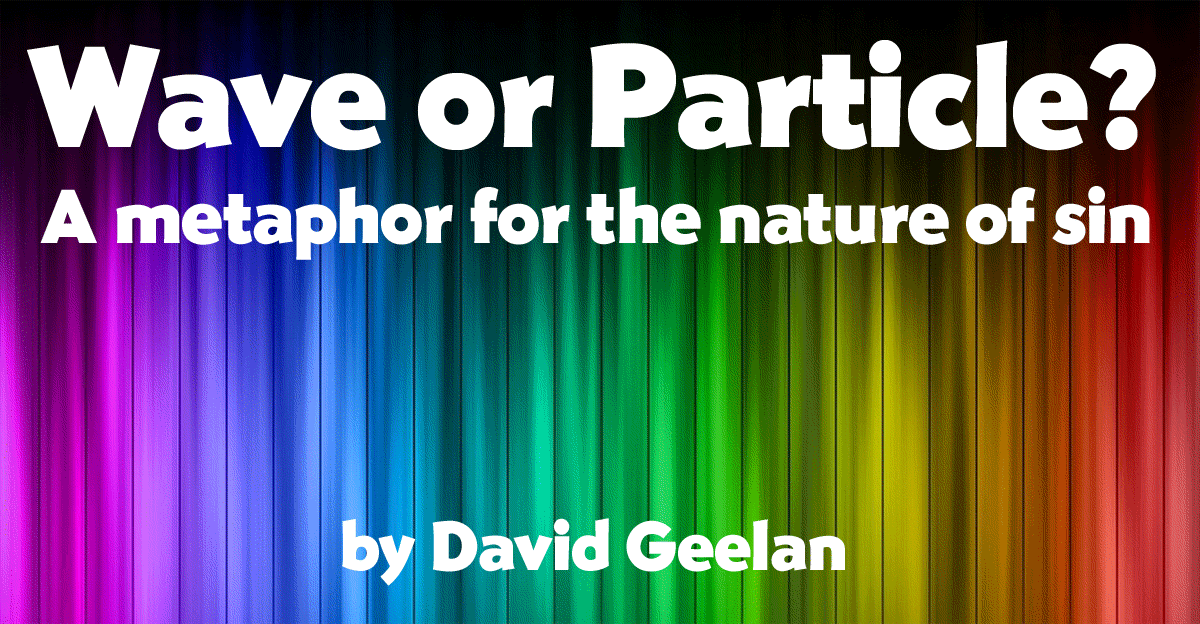Is Sin a Wave or a Particle?
by David Geelan | 28 December 2021 |
What is the ‘nature of sin’? Is sin something we do, or is sinners something we are? Is sin the transgression of the law, or is it a state of separation from God? These are questions guaranteed to spark furious (and often circular) debates among believers, and have been doing that for centuries.
Let me try to explore this in a different way by taking an analogy from science: the ‘nature of light’. It has been discussed since at least the time of Democritus, Plato and Aristotle. Epicurus suggested that atoms flow from objects into our eyes, while Plato believed that beams originate in our eyes and travel outward to enable us to see. Plato’s theory was influential for more than 1,000 years, until it was challenged by Alhazen.
Two ways of looking at light
The study of light moved to the Islamic world from the Hellenic in around 800 CE. Al-Kindi seriously studied optics, and Ibn Sahl is believed to have stated what we now know as ‘Snell’s Law,’ describing the refraction of light nearly 600 years before it was stated by Snell.
Abu Ali al-Hasan ibn al-Hasan ibn al-Haytham became known as Alhazen, and his Kitab-al Manzir (Book of Optics) is arguably the most influential book on the topic until the time of Isaac Newton. Alhazen rejected Plato’s ‘extramission’ notion of beams emanating from the eyes and replaced it with a more modern understanding of the origin and reflection of light.
By the time of Newton and Huygens, the debate had moved on from the question of whether light rays emanated from our eyes or from the objects we are looking at, to the question of whether light was, in its most essential nature, made up of waves or particles. It is in this debate that we find our analogy for the nature of sin.
There is evidence that suggests that light behaves like a particle: it is reflected when it bounces off something, with the angle of reflection equal to the angle of incidence. The thing is, waves do that too. You may have seen ocean waves reflect back from a beach or sea wall. Waves are refracted when they cross from deep to shallow water or vice versa, but rolling objects slow and bend their path when they move on to surfaces that offer more resistance to their motion. Many of the properties of light are equally well explained by analogy to either waves or particles in our experience of the physical world: that’s one of the reasons the debate wasn’t immediately solved by experiments.
Newton advanced a ‘corpuscular’ theory of light that treated a ray of light as a beam of particles. This theory explained most of the available evidence. It incorrectly predicted that light speeds up when it enters a more optically dense medium, where in fact it slows down, but precise measurements of the speed of light in different media were impossible at the time. It struggles with the phenomenon of diffraction (light bending around the edge of an object), but Newton surmised that this was simply refraction in the atmosphere close to the object.
At around the same time, Christian Huygens advanced a wave theory of light. He incorrectly considered light waves to be transmitted in a ‘lumeniferous aether’ as sound waves were transmitted in air and to be longitudinal rather than transverse, but his theory explained the speed of light and other phenomena.
Both Newton and Huygens were enormously influential, but arguably Newton was more so, and certainly in England his corpuscular theory was much more widely ascribed to than a wave theory, until the ‘double slit’ experiment of Thomas Young demonstrated wave-like interference patterns in light. I won’t describe the experiment here, but a brief google will provide plenty of examples and discussions.
The double-slit experiment was considered to definitively support Huygens’ wave model and to falsify Newton’s particle model, and a wave model of light was dominant from the early 19th century until the early 20th.
By the end of the 19th century some physicists believed that physics was almost ‘finished’ in terms of great new discoveries: there were just more and more precise measurements, to be made… and a few small loose ends to be tidied up.
In 1905, though, a young patent clerk named Albert Einstein, influenced by the early work on quantum physics, started picking at one of those loose ends: a phenomenon called the photoelectric effect. Again, I won’t explain the experiment in detail, because there are plenty of better and more visual explanations and simulations available around the web, but the short version is that when light is shone on the surface of some metals, electrons are released from the metal. Light of a long wavelength will not release any electrons, even if it is very bright. On the other hand, higher energy light of a shorter wavelength will release these photoelectrons even if it is quite dim.
Explaining this phenomenon in full required a synthesis of both wave and particle models of light. Since the phenomenon is clearly wavelength-dependent, a wave nature is part of what is going on. But at the same time the full features of the experiment and its interpretation show that the energy is not arriving continuously over time as we would imagine with a wave, but in discrete tiny individual ‘packets’. We now call these packets ‘photons’ and understand them as small local collections of waves within a very small space.
We could argue that light was never, and is not now, either a wave or a particle. Rather, we used waves and particles as analogies to try to connect the strange (and tiny) phenomena of light with our experience of the world around us. Light shares some characteristics with light and some with waves, but it is simply light: a phenomenon of interacting electric and magnetic fields that is also quite different in several ways from both waves and particles.
The nature of sin
That’s a longish digression into the history of science, but I hope the parallels are already forming in your mind. There is Biblical evidence for both ‘sin is the transgression of the law’ (1 John 3:4) and for ‘whatever is not of faith is sin’ (Romans 14:23). I won’t go into a full analysis here of all the relevant Biblical passages, partly because I think most readers on Adventist Today will already be very familiar with that literature and those arguments and partly because I’m a science guy, not a theologian.
I think both perspectives have something valuable to help us understand. The book of Romans addresses the role of sin and the law in some detail. If we understand the law as a human-scale depiction of the character of God – a proscription of things that we will not do if seeking to live as God intends – perhaps there is a synthesis of these two perspectives.
Jesus takes it a lot further, moving backward in the causal chain from action to intention: if you’re committing adultery in your heart, it is as though you had done so in bed; if you are murderously angry mentally, it is as though you had killed. This is a much higher standard; our actions are likely controlled by human laws, social contracts, relationships and so on, but our minds are not contained in these ways. God says to Samuel, ‘Humans look at the outward appearance, but I look at the heart’ (1 Samuel 16:7).
Sometimes what’s in our heart gets out in our words, even if not in actions. Jesus said, “Out of the fullness of the heart, the mouth speaks” (Matthew 12:34; Luke 6:45). He also said that if we say ‘Raka!’ (meaning ‘useless, worthless’) to someone, we’re in danger of hellfire.
Jesus also asks us to do much more than just refrain from evil, but to proactively do good, and return good for evil. To turn the other cheek, to go the second mile, to give the shirt off our back if we’re asked for our coat. This is a code about concern for the other, not about personal purity and righteousness. The righteous act lies not so much in refraining from evil (although that is also enjoined and necessary), but in actively doing good. The Parable of the Sheep and the Goats (Matthew 25) makes this explicit and focuses it on the ‘least of these’ – the most vulnerable in our community and our world.
The claim that sin is in our actions and is something we do, rather than something we are or a state we are in, is often linked to perfectionism: the idea that if sin is something we do, then it’s something we can stop doing. While there is often the addendum ‘through God’s power and the aid of the Spirit’, there nonetheless seems to be a lot of striving still involved to live that perfect, sinless life.
An impossible standard
At Jesus’ much higher and more challenging standard of governing not just our actions but our thoughts, and of actively doing good rather than simply not doing evil, it becomes clear that this standard is impossible to reach perfectly 100% of the time. Even if someone is able to cease the sins of commission, there always remain the sins of omission: there is always more good that could be done.
Perhaps ironically, the synthesis of the nature of sin may well lie in taking the focus away from self and away from sin, and to placing it on goodness and virtue, on right thinking and right acting, where that is defined as a genuine love and respect for the humanity of every human being, and to actions that actively seek to improve the lives of others. A life of service is so much more fulfilling, so much less harried and worried, so much more attractive, than endless circular debates about whether sin is a wave or a particle.
Acknowledgements: Thanks to Nicki Carlton for sparking the thoughts that led to this piece, and to Suhail Zubairy, whose article ‘A Very Brief History of Light’ (published in 2016 in the book Optics in Our Time and freely available online) enhanced my knowledge of this fascinating discussion in the history of science.
 Dr. David Geelan is Sue’s husband and Cassie and Alexandra’s dad. He started out at Avondale College, and is currently Professor and National Head of the School of Education, within the faculty of Education, Philosophy and Theology at the University of Notre Dame in Sydney, Australia.
Dr. David Geelan is Sue’s husband and Cassie and Alexandra’s dad. He started out at Avondale College, and is currently Professor and National Head of the School of Education, within the faculty of Education, Philosophy and Theology at the University of Notre Dame in Sydney, Australia.




